[Westwater
Mining] > [Library]
> [Nanaimo
Mine Tour]
Getting the Coal, Down in the Hole:
a virtual underground tour
by Gwyneth Cathyl-Bickford, P.Geo., Colliery Geologist
Most histories of Vancouver Island mining will mention that the
last underground coal mine at Nanaimo closed in 1967. While it is true
that the last of the 'small mines' closed in that year, there was a brief
resurgence of interest in underground mining at Nanaimo in the 1980s, following
upon the skillful discovery of an isolated outlier of the Wellington coal
bed on Wolf Mountain, south of Mount Benson (and within sight of downtown
Nanaimo).
I invite you to join me on a short tour of Wolf Mountain Colliery, through
the convenient auspices of your computer. Unlike the men and women who
worked at the mine during its brief life, you won't end up with a coal
dust grin at the end of your tour, nor will you be able to take any 'free
samples' home for your fireplace. But you will, I trust, learn something
about the Wellington coal bed and how it was mined in the little colliery
atop the big mountain.
Discovery of the coal
Back in 1942 and 1943, Alex Fraser Buckham mapped the geology of the Nanaimo
coalfield. His blueprint map, published by the Geological Survey of Canada
in 1947 as their Paper 47-22, showed a small outlier of the Extension
coal-measures atop Wolf Mountain, southwest of the city of Nanaimo. On
his map, he showed three 'prospects', but did not provide any notes concerning
exactly what was found at each prospect.
As it turns out, the prospects at Wolf Mountain were short, probably
hand-driven, adits into thin beds of coal and carbonaceous mudstone. They
were probably driven by the Western Fuel Company in or about 1917. In the
1930s, the Company drilled two exploratory boreholes with their diamond-drill,
these being the last two boreholes that they ever drilled at Nanaimo. Getting
a steam-powered drill-rig up to the top of Wolf Mountain was in itself
a task worthy of Hercules; drilling through the hard, siliceous conglomerates
of the Extension Formation was also probably rather hard work.
The two boreholes proved the existence of several thin coal beds on
the mountain, but nothing particularly exciting to the miner. At the time,
the Company's drillers and geologists probably thought that they had reached
the Wellington coal bed in at least one of their boreholes; given the apparent
absence of thick coal, there was little inducement to proceed. Nothing
more was done until 1980, when Gulf Canada Resources commissioned a coal
geologist, John Perry, to examine various coal properties in the Nanaimo
coalfield.
Perry did some geological mapping, and then he selected several sites
for exploratory boreholes. The fifth borehole of the exploration programme
was situated on the top of Wolf Mountain, intended to test the entire thickness
of the Extension coal-measures as preserved in the core of a shallow syncline
which capped the mountain. The borehole was a success, striking the Wellington
coal bed and continuing down a great depth further into the mountain, effectively
testing the strata both above and below the coal.
In 1981, the owners of the property, Netherlands Pacific Mining, drilled
several more boreholes at Wolf Mountain, proving the existence of sufficient
coal to warrant design and construction of a small underground mine. Some
of the holes were cored, and some were rotary-drilled, but all the holes
were geophysically logged, which afforded an excellent basis for the study
and correlation of the coal beds.
Engineering and building the mine
Eric Roberts, a mining engineer from West Vancouver, designed a small 'punch
mine' to work the Wellington coal at Wolf Mountain. Punch mining is a technique
perfected in the Appalachian coalfields, of driving a few narrow entries
in from the outcrop of a coal bed, and then developing a series of rooms
and crosscuts further within the coal. Punch mines do not require much
in the way of capital or equipment, since virtually all the miners' efforts
are directed at digging within the coal bed, and no 'dead work' such as
shaft-sinking or rock-tunneling must be done.
Construction of the mine commenced in 1983. An overgrown logging road
was reopened, and some rock-work was done to extend the road up over a
sandstone bluff and onto the floor of the Wellington coal bed. Soil, glacial
till and rock debris were scraped away until the coal was exposed in the
face of the mountain. A pair of adits were driven into the coal, and a
'bulk sample' of the coal was taken so that its quality could be evaluated;
the bulk sample also provided material that could be sent to prospective
customers for their own burning tests on the coal.
Although the Wellington coal at Wolf Mountain is relatively rich in
reactive constituents, it cakes only weakly and therefore does not
make a good coking coal. Its calorific value and volatile content are both
sufficiently high that it makes an excellent free-burning coal for domestic
heating or steam-generation, as well as a good raw material for cement-making.
Once customers for the coal had been found, the mine was put into production
under a limited production permit, which allows for a certain amount of
coal to be mined on a more-or-less experimental basis. Various pieces of
used mining equipment such as continuous miners, shuttle-cars and conveyors
were rounded up from coal mines across Western Canada, and the call went
out for miners to maintain and operate the machinery and 'dig' the coal.
Digging the coal
In a punch mine such as Wolf Mountain, very little 'digging' actually happens.
Most of the coal is produced by a continuous miner, which is a large caterpillar-mounted
machine with an articulating chisel-studded boom at its front end, beneath
which are oscillating gathering-arms which pick up the coal and propel
it backwards through the machine. The back end of the continuous miner
consists of an armoured conveyor which lifts the coal up and drops it into
a shuttle-car.
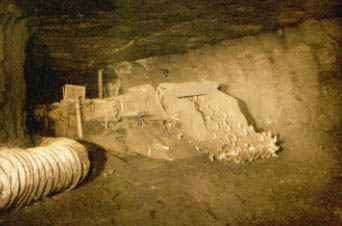 |
This is the business end of a Joy continuous miner. Cutting teeth at
the front end of the miner pick the coal from the working-face, and the
gathering-arms underneath the cutter propel the coal to the back end of
the miner, where the shuttle-car is loaded. The operator sits behind the
wire-mesh 'windshield', which protects against flying blocks of coal.
The spiral-wound fabric ventilation duct ensures a supply of clean air
at the working-face. |
The shuttle-car, as its name implies, is a wheeled 'car' (rather like
an overgrown steel bathtub on balloon tires) which 'shuttles' back and
forth between the continuous miner and the receiving-end of a belt-conveyor.
The shuttle-car takes about 40 tonnes of coal as a load, and makes a round-trip
between the miner and the conveyor every ten to fifteen minutes.
In between loads of coal into the shuttle-car, the continuous miner
cuts coal off the working face of the mine, and then when the shuttle-car
comes back for a load, the miner gathers up the loose coal from the floor
of the workings and conveys it into the car. The word 'continuous' is therefore
somewhat inaccurate, since the miner cannot continuously dig and load coal
unless there are machines available to continuously take the coal away,
and to install roof support above the miner. Such machines do exist, but
they are expensive, and even the fanciest of equipment seldom attains the
ideal of true 'continuous mining'.
| The walls and roof of this working place show the marks made by successive
passes of the miner's cutting drum. Six roof bolts, each with square steel
bearing plates, have been installed into the roof. The light patches around
the roof bolts are due to cuttings sprayed out by the drill that made the
bolt-holes. A yellow paint line marks the intended centre-line of this
place. The dark 'window' in the back of the place shows where the miner
broke through the coal rib into an adjoining roadway. At the extreme right
of this view, the end of the ventilation duct can be seen. The coal face
and walls are coated with limestone dust to forestall coal-dust explosions. |
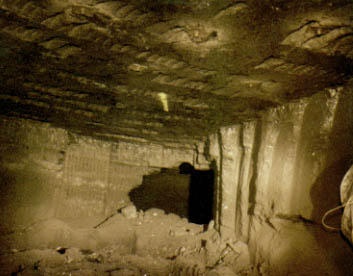 |
Putting all of this into perspective, a crew of seven miners could easily
produce and convey 400 to 600 tonnes of coal out of the mine during a single
shift. The 'output per man-shift' (a time-honoured means of assessing the
productivity of a coal mine) would therefore be 57 to 86 tonnes. Compare
this to the 4 to 6 tonnes per man-shift that a well-run mine would have
gotten out of the Wellington coal bed in the 1930's, when most mining operations
were driven either by small compressed-air motors, explosives, or human
and animal muscle-power.
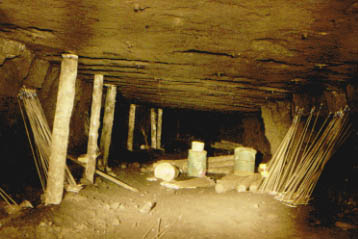 |
Roof bolts first came into use on Vancouver Island in the late 1950s,
in Tsable River Colliery. If used intelligently, they made for much stronger,
and much more permanent, support of the mine roof.
The bolts in this view are eight feet (2.4 m) long. They have threaded
expansion shells on their ends. The drums contain steel bearing-plates
that fit between the roof and the bolt-heads.
Note how the rows of bolts in the mine roof are staggered to deal with
local geological structures. |
In comparison with the old mines, Wolf Mountain used comparatively little
timber (other than where the workings crossed fault zones). Without the
use of modern roof bolts, it is questionable whether some of these roadways
could have been driven as wide as they were (5.5 to 6 metres, as compared
with the 2.4 to 3 metres in older coal mines at Nanaimo). Wider roadways
allow for greater coal production per unit of advance, but the choice of
roadway width must always be made carefully, giving due regard to the bulk
strength, weathering characteristics, and local irregularities of the roof.
All in all, Wolf Mountain was a good mine to work in, and it still has
a fair bit of coal awaiting the miner's pick.
Short but brilliant lives
Wolf Mountain Colliery worked about half-time between 1983 and its closure
in January of 1987. Although the Wellington coal was good and thick and
abundantly present within the mountain, the commercial market for steaming-coal
was gyratory to say the least. The miners would work for a few weeks to
a few months, filling an order for coal, and then the mine would shut down
until another order could be secured. This was not unusual practice for
a small North American coal mine, but it did make life interesting for
the miners.
For the people who worked at Wolf Mountain, it provided more than a
pay-cheque. Good friendships grew up out of working together at close quarters
inside the belly of the mountain. Some of the miners, such as manager John
Burns, were among my former workmates at the Sukunka Mines in northern
B.C., and others came from the various collieries of Canada: Coleman, Balmer
and Smoky River in the southern Rocky Mountains of B.C. and Alberta, and
the Evans Mine in Nova Scotia. After Wolf Mountain closed, many of the
workers and much of the equipment ended up at Quinsam, an up-and-coming
colliery farther north of Vancouver Island. Some of the people went down
East to a new mine at Westray, in Nova Scotia. Two of those men, my friends
Trevor Jahn and Ferris Dewan, died when Westray exploded in 1991.
A geologist's playground
There are two kinds of geologists in a working coal mine: the cautious
and the injured. I preferred to be cautious, keeping an eye out for moving
equipment, standing well clear of the bight of the trailing-cables that
supplied power to the machines, and making sure that everyone underground
knew where I would be working on any given day. The episodic nature of
Wolf Mountain's operations did afford the opportunity for some geological
experimentation, in that I had the luxury of setting-up my camera on its
tripod in the middle of the haulageways on quiet days, and taking pictures
of the mine's equipment and geological conditions.
It is fair to say that in most working collieries, the geologist does
not have the luxury of measuring the coal bed in detail at each and every
roadway intersection. In some areas of geological complexity, I measured
sections 30 cm to 1.5 m apart, which is an unusual level of detail. This
attention to detail allowed me to unravel the depositional and structural
history of the Wellington seam, including the local effects of inferred
paleo-earthquakes upon the coal-forming peat mires.
Like most geologists, I still catch myself wishing I could go back and
spend "just one more day, please!" mapping in the mine. No matter how much
time I spent, I am sure I could not have exhausted all the possible questions
and curiosities presented by the coal.
A geologist's rounds
During 1985 and 1986, I spent every third Friday, more or less, at Wolf
Mountain. On the Thursdays beforehand, I would fly in to Vancouver on an
early-evening plane from Calgary. Early on the Friday morning I would arise
and make the short, frantic commute from our home in Kitsilano across downtown
Vancouver, and out along the Upper Levels Highway to the ferry terminal
at Horseshoe Bay. To catch the seven o'clock boat meant leaving the house
at ten to six, which at least gave me easy traffic through the city as
well as the chance to catch the daily weather forecast on the CBC radio.
The boat arrived at Departure Bay in Nanaimo at twenty to nine; on winter
mornings I would stand in the ferry's forward lounge and watch as the dawn
painted the snow-covered eastern face of Mount Benson with a delicate pink
wash. Off to the left, just below the morning skyline, the lamps of the
mine-yard glowed as solitary sparks within the darkly-treed mass of Wolf
Mountain. Sometimes I would be lucky enough to catch a glimpse of a coal
truck rumbling by as I drove through the streets of Nanaimo, climbing up
towards the mine.
Wolf Mountain was about 700 metres above sea level, which doesn't sound
like much of climb until you do the last half of it on a snow-rutted, unploughed
road through the forest (or up through the rain-soaked woods during the
summer).
By the time the mine closed in 1987, I had a box full of geological
maps, a half-dozen books of notes, three boxed pillar-samples of the coal,
and about 20 good photographs taken underground. These formed the basis
for a Master's project in Dr. Marc Bustin's coal laboratory at the University
of British Columbia, and a couple of geological papers. Together, these
are the formal results of my days spent inside the mountain. The results
for my heart are the basis for our virtual tour of Wolf Mountain Colliery.
And now... for the tour itself.
Upon arriving at the mine, the morning drill was always the same: park
along the edge of the mine-yard, and walk into the Quonset hut that served
as workshop, lunchroom and lamp-cabin, to take my morning tea with the
dayshift foreman. We'd get caught up on affairs both worldly and coaly,
then I would fetch my lamp from the rack, strap it to my pit-belt and walk
through the mud-puddles or snow-drifts to the mine entry.
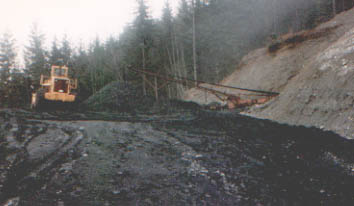 |
Looking southward across the mine-yard on a wet morning. The conveyor
brought the coal out of the Belt Portal, and the loader transferred the
coal into the haulage trucks.
The grey material in the hillside is glacial till, which abuts the subcrop
of the coal. The loose coal in the mine-yard is about 50 cm thick; underneath
it is the sandstone floor of the Wellington coal bed. |
Lugging my load
I generally took an extra lamp with me, looped over my neck like a mink
stole, so that if something happened to my headlamp I could still find
my way back out of the mine. I also carried a 'self-rescuer', which was
essentially a containerised gas-mask that could have made all the difference
for me if I had to escape the mine following an explosion. The self-rescuer
did not contain an independent oxygen supply, so it would have been little
help if I had been caught up in a rolling methane fire or been unlucky
enough to be at the centre of a dust explosion, but it would filter out
the dreaded 'afterdamp' or carbon monoxide that usually forms after explosions.
Besides the two lamps and the self-rescuer, I carried a shoulder bag
with a hammer, chisels, large nails, carpenter's chalk, tape-measures,
compass and notebook. A water-bottle and a sandwich wrapped in wax-paper
made for a good lunch underground. In the winter, I wore a heavy wool Cowichan
sweater (a gift from my sister-in-law) and insulated, steel-toed gumboots.
In the summer I wore a black denim shirt (colliers since time immemorial
have regarded black clothing as being more practical than a mere fashion
statement). I always carried and wore safety glasses and ear-muffs as well
as my hard-hat and steel-toed boots.
| The Belt Portal was supported by segmental colliery arches, which were
bolted together from easily-portable pieces. Wooden lagging between the
arches supports the sidewalls of the roadway.
Ice and snow accumulated near the portal during the winter months, because
of the cold air current that flowed into the mine. |
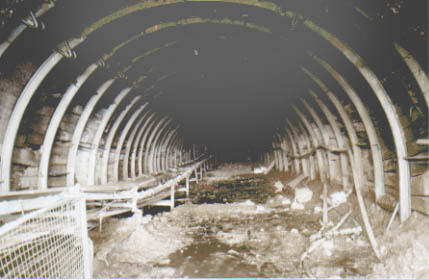 |
The mine had two portals: the Fan Portal (which had a yellow steel air-lock
with a tower through which the air was blown by a fan) and the Belt Portal
(through which came the conveyor belt that carried the coal). Most of the
mine's personnel and supplies went in and out through the Fan Portal, which
was unobstructed other than by the twin sets of air-lock doors, but I preferred
to walk in and out through the Belt Portal, which had rather more interesting
geology although part of its width was taken up by the conveyor that brought
coal out of the mine.
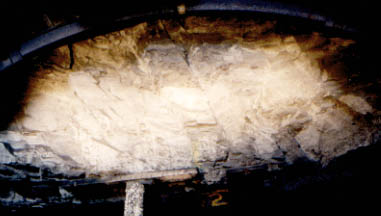 |
At the inbye end of the arches, the brow of the Belt Road showed the
thin-bedded sandy siltstone that formed the roof of this part of the mine.
The arches were semicircular, and about 4.3 metres in diameter. They
were held together by large bolts and metal clips. |
The Belt Portal was made of steel arches, lagged by corrugated steel
sheets and coarse wire mesh, but further into the mountain the arches ended,
and the Belt Road was supported by timber sets.
Near the portals, the Wellington coal bed was split by a thick parting
of sandy siltstone (which I mapped as the Upper Parting -- not a terribly
imaginative name, but at least it clearly expressed where the parting came
within the overall coal zone). Farther into the mine, where the Upper Parting
thinned, the entire coal bed was worked, partings and all.
| Most of the mine's equipment was electrically driven, and the power
cable ran in along the Belt Road.
The roof here is formed by the Upper Parting, with the overlying Rider
coal left unmined owing to the parting's great thickness. Note the arched
appearance of the roof, where flakes have come down in between the roof
bolts and timbers.
|
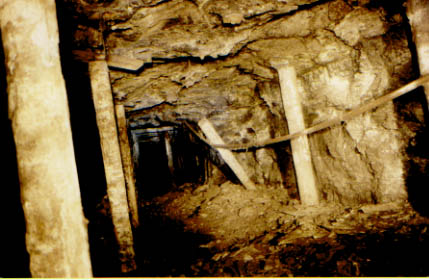 |
The Upper Parting was sensitive to moisture, and thus it tended to flake
and fall along the Belt Road. Although this made for rough going when walking
into the mine, the fallen pieces of siltstone often contained plant fossils,
including very large palm fronds.
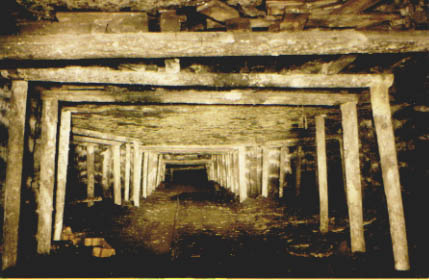 |
Timber support was used in the older workings of the mine, and for
the most part it worked well. Note how the roof is further supported by
stacked planks, bars and wedges.
The dark patches in the roof are coalified plant leaves and stems, including
those of palms, cypresses, dawn-redwoods and gingkos. |
From the Belt Road, I usually turned right and walked northwards into
the old workings of the mine's first working panel, North 1-A's. These
'old workings' were mostly driven in 1984, from 5.4 to 6.1 metres wide
and the full height of the Wellington coal bed, which here was usually
between 2.1 and 2.9 metres. To the miners of the 1930s, who sometimes had
to crawl into longwall faces only 55 centimetres high (as at Wakesiah Colliery),
this would have seemed almost palatial. Any place much over 2.1 metres
high left me feeling a bit uncomfortable, since I could no longer easily
touch the mine's roof with my hand.
| Light-coloured glacial till cuts down along the subcrop of the coal
bed. When you find this, it's time to stop mining.
The white rectangular patch on the wall of this place is my field notebook,
15 cm tall.
The long thin rod projecting down from the roof is a piece of drill
steel, the top end of which went up through the ground surface, which is
why it became stuck in the roof. I found its top sticking up next to a
tree in the forest above the mine. |
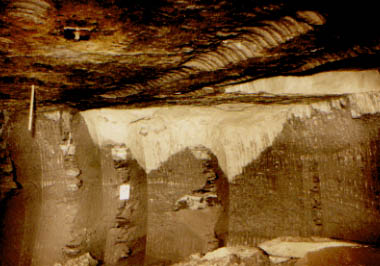 |
North 1-A's was in many ways an experimental area within the mine. Different
methods of roof support were tested, and roadway orientations and working
sequences were changed until the best approach to working the Wellington
coal could be identified. Along the northeastern side of the panel, the
coal was worked all the way out to its subcrop beneath glacial till. This
made for interesting geology, because the coal was not appreciably weathered
along the subcrop, and the Cordilleran ice-sheet had clearly gouged a fair
ways into the coal.
Because of the gradual truncation of the workable area by glacial erosion,
North 1-A's was eventually abandoned in favour of a new panel further into
the mountain. Several roadways were driven westwards towards the proposed
new working area, but before they could get there, a fault had to be crossed.
Faults nearly always cause dislocation and disruption of the roof of a
coal bed, and this fault certainly did its part to make the miners' lives
more interesting.
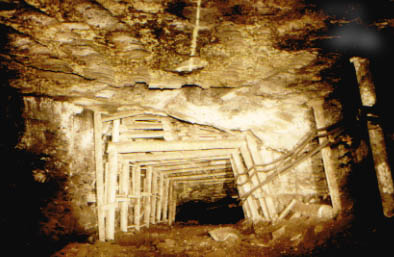 |
Looking further into the mine, down the First Right Counter Entry as
it enters a fault zone. The actual fault step is visible at the far end
of the timbered section; here the roadway steps down abruptly to pass through
the main part of the fault. The coal bed here is about 3.5 metres high.
A power cable, air hose and water line are hung along the right side of
the roadway, out of harm's way from passing vehicles. |
The First Right Counter Entry was, as its name implies, the first entry
paralleling the main Belt Road, on its 'right' or northern side. A combination
of roof-bolts and timbers was used to support this roadway. Where the roof
rose up high above a minor fault, the miners built cribbing to support
it. Sometimes the timbering has a craftsmanlike beauty of its own, but
it's still very hard work to get it up above the roadway -- these are large
round poles and logs, up to 40 cm in diameter, accompanied by square baulks
of cut timber up to 20 by 30 cm in cross-section.
Above the timbers are wedges, holding them tight against the roof. Alongside
the roadway, rough slabs of timber lagging are placed to keep loose coal
and rock from sliding down into the travelled area.
| Here the miners have found more difficult conditions. Two successive
roof-falls have partially blocked the roadway, and crushed the timbers
that were put in to repair the damage from the first fall. Note the cribbing
above the timber booms, and the roof-bolts that have been installed to
pin the booms into place.
This photo was taken from the safe side of a barricade, upon which was
written the words 'No Road'. Understandably, this would not have been a
safe place to explore further. |
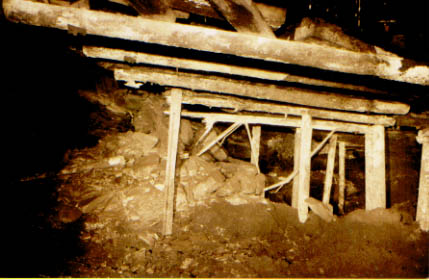 |
Roof conditions at Wolf Mountain were generally quite good, but some
roof falls did occur in areas where the roof was intensely-jointed or fractured,
or where support was delayed for one reason or another. Most of the time,
the miners got some support up just as soon as the place had been mined,
since it is unsafe (and forbidden) to work under unsupported roof. Places
that could not be made safe were barricaded, or stowed with waste rock.
Most of my work consisted of measuring the section of coal and rock
exposed in the corners of the pillars, and at the advancing working-faces.
After I had measured about 20 sections (I eventually measured 229 sections
in the mine), I began to form a model of the depositional history of the
Wellington coal bed, from observing the variations in thickness and rock
type within the overall zone.
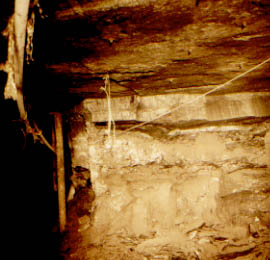 |
Looking north along the panel conveyor road into the new working-panel,
North 1-B's, at its junction with the First Right Counter. This pillar
is about 3.3 metres high.
Here the roof is supported by bolts, with a few timber posts put in
for the dual purpose of protecting the workers (by warning them of impending
roof failure, by their crushing beforehand) and supporting power cables
and water pipes. The loop of rope in the middle of this view supports the
mine's underground telephone cable.
The bright banded coal of the Wellington Rider is visible at the top
of the pillar. This strong coal often projected outwards over the underlying
mudstones of the Upper Parting. |
At the top of the coal zone was the Wellington Rider coal, which was
a distinctive couplet of two bands of hard coal, separated by a distinctive
band of 'speckled' coaly mudstone, possibly an altered volcanic ash layer.
Below the Rider was a series of interbedded coal and shale bands, with
occasional thin bands of sandy siltstone. In most cases, the cleanest and
best-looking coal was just above the sandstone floor of the mine. The miners
learned that it definitely paid to dig all the way down to the floor, even
though this basal coal was quite hard and thus more difficult to mine.
Further to the north into panel North 1-B's, the coal was a bit thinner,
owing to the sandstone floor having risen up in a series of ridges. These
ridges may have been ancient beach ridges, formed when the sand (which
later became sandstone) was deposited along an exposed coastline. This
must have been a wild landscape back in the Late Cretaceous era, with salt
winds blowing over forested coastal wetlands, and the sound of crashing
surf in the background.
| Here the coal bed has thinned to about 2.4 metres, still a comfortable
height for working. The roof is supported by bolts, with protection posts
along the roadside where the operator of the continuous miner would have
been while the road was being driven.
A few blocks of coal have fallen off the corner of the pillar, indicating
that it has taken a bit of a squeeze, but nothing worthy of
great concern.
The painted triangle in the roof shows the planned centrepoint of the
roadway junction. |
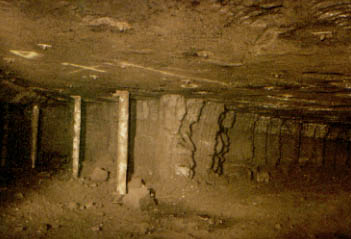 |
During one working shift, I could measure eight to ten sections of the
coal bed. Each one took a fair bit of time to examine, especially given
that I sometimes had to dig a fair distance down through loose coal to
get to the sandstone floor of the coal bed. Patient measurement and consistent
levels of detail allowed me to build a useful depositional model of the
coal, and afforded the ability to predict changes in the coal quality and
mining conditions a few weeks to a month in advance.
By the end of the shift, I was ready to go home. The walk back out of
the mine was always easier than the walk in, because my eyes would have
fully dark-adapted after six or seven hours at the working-face. My lamp
seemed to shine all the more brightly when I knew that I was done for the
day.
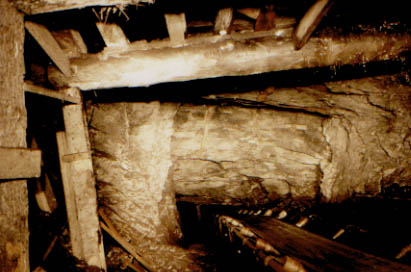 |
On my way out of the mine, I often walked out alongside the main conveyor,
on the Belt Road. In the winter, snowflakes sometimes were blown this far
into the mine by the air current.
The conveyor is passing down through a fault here. The rock face shows
the bedded siltstone of the mine's roof.
The timber boom visible against the roof is about 45 cm in diameter.
Lifting it into place was quite a daunting task. |
The first glimpse of sunlight, even though I was still a couple of hundred
metres inside the mountain, was lovely to behold. I made several water-colour
sketches of this scene, looking out along the Belt Road towards the portal.
| The Belt Road had a wide travelling-way along most of its length, and
it was well-marked with 'Exit' signs to guide one's way home.
The centre-posted timbers in the background are just inbye of the brow
of the arched section of this road. Extra support was needed to carry the
weight of the Upper Parting between the Rider coal and the main part of
the Wellington bed.
Water is ponded in low spots on the belt, because the mine was not working
on the day this photo was taken. |
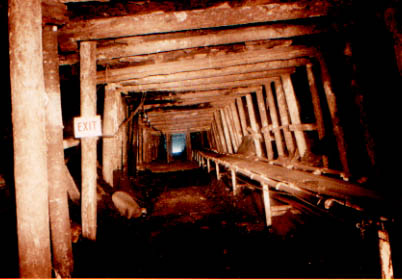 |
Having come back out of the mine, it's just a short walk to the workshop
where the lamp-rack is. By plugging the lamp into the charger, you can
ensure that you will have a fresh light the next time you come to work
in the mine. A palatial wash-trailer sits up a side-road in the woods,
and here you can take a well-deserved shower, for your workday is done.
Here ends our brief tour of the mine. Samples of coal for your fireplace
are, alas, unavailable over the Internet. But you might be willing to take
my word for the good burning properties of Wolf Mountain coal, as it lit
many a fire in our house in Kitsilano, to the great amusement of our friends
and neighbours.
Words of advice
Coal mines can be very dangerous places indeed, especially if you are trying
to do something you shouldn't be doing, or are going someplace you shouldn't
go. As Westray reminded us, things can go 'bump' in the night. Sources
of ignition in a coal mine can be obvious ones, such as matches or cigarette-lighters,
welding-torches or arcs from accidentally-severed power cables. They can
also be less obvious, such a sparks struck from light metals such as aluminium
or magnesium, or from an accidentally-crushed LCD display or battery-powered
flashlight.
How I took the photos
I took my photographs using a steel-bodied 35-mm camera, from which the
batteries had been removed. The camera was mounted on a wood-and-brass
surveyor's tripod, for sake of steadiness during long exposures. The camera's
shutter was controlled with a squeeze-bulb made of plastic and rubber,
that would hold the shutter open for the very long exposures that were
needed.
Kodak 400-ASA colour negative film was exposed at wide-open lens stops
of f-1.4 or f-1.8 depending on the lens being used; exposures of light-coloured
rocks such as sandstone or siltstone were typically 5 minutes long, and
for darker rocks such as coal or mudstone they were 7 or 8 minutes long.
I bracketted most exposures by a minute either way, thus taking three shots
of most scenes. The film was processed normally, with no special 'pushing'
or exotic chemistry.
Lighting was supplied by the same miner's headlamp that I used every
day I went down the mine. The only special care I took was to ensure that
the lamprack's meter showed the lamp's battery to be fully charged, and
that the lamp's bezel was kept clean and unsmudged. Since a miner's lamp
either gives a little light in a broad beam or a little bit more light
in a narrow beam, I 'painted' each scene with the lamp, keeping the beam
moving across the scene, and dwelling a bit longer on particularly dark
parts of the scene, or on features which I wished to accentuate in the
photograph.
Thanks to the following
What I know of underground photography in coal mines, I learnt from two
wise geologists, Dave Mitchell at BP and George Kakizaki at Mitsui Mining,
who patiently taught me some of their craft. Ali Chowdry and Andy Bowler
taught me coal-mining geology, and John Burns gave me some insight into
what's important to a colliery manager. Thanks also to Judith Harrow for
helping me figure out how to fit pictures into Web text.
The address of this document is: http://www.westwatermining.com/library/wolftour.html
This document was most recently revised on June 24, 2001.
Copyright to original material included herein is held by Westwater
Mining Ltd., © 2001.
Distribution restriction: This document may be freely copied and distributed
for educational purposes, provided that Westwater Mining Ltd. is duly credited,
including a link to our web-site.
[Westwater
Mining] > [Library]
> [Nanaimo
Mine Tour]














